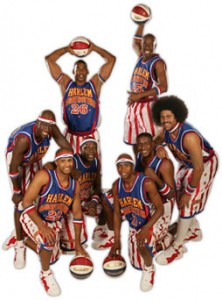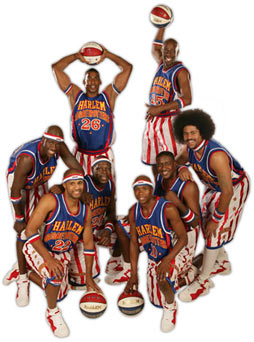By Gary Collins/managing editor

For more than 80 years, the Harlem Globetrotters have trotted their way across the globe entertaining approximately 120 million fans.
In their time, the Globetrotters have amounted more than 20,000 victories and 332 loses, but today they are best known for comedic on-court hijinks, ball passing and twirling to the song “Sweet Georgia Brown.” The Globetrotters also have a history of serious play.
Through the years, the Globetrotters have been known as the Savoy Big Five, Saperstein’s New York Globetrotters, Harlem New York Globetrotters and finally the Harlem Globetrotters. Although they did not play their first game in Harlem until 1968, Harlem was added to the name to show that they were an all-black team.
In 1926 in Chicago, a 24-year-old Abe Saperstein founded what was then called the Savoy Big Five, named after the Savoy Ballroom in New York.
The ballroom hosted many of the Big Bands of the decade, but when business dropped, the owners decided to schedule the Savoy Big Five, hoping to attract potential customers to the dances.
The basketball games failed to attract dancers, and the idea was soon dropped.
After the team disbanded, members Randolph Ramsey, Lester Johnson, Inman Jackson and Walter Wright formed the core of the Saperstein’s New York Globetrotters. Acting as owner, manager and coach, Saperstein substituted for injured players.
Traveling in Saperstein’s Model T Ford, the Globetrotters competed in their first game in Hinckley, Ill., Jan. 7, 1927, to a crowd of 300 with a pay out of only $75.
During a 1939 New York game, the team was ahead 112 to 5. To keep themselves and spectators from getting bored, the Globetrotters began to entertain themselves by acting silly and finding comical ways to pass the ball.
After the game, Saperstein told his team clowning around was acceptable only after they had a safe lead. The routines would eventually become their best-known gag.
By the 1950s, the NBA began recruiting black players, and the Globetrotters struggled to stay competitive as many players chose the NBA over the Globetrotters.
By the time Saperstein died in 1966, the Globetrotters had played 8,945 games in 1,200 cities and 82 countries.
In 1951, the State Department asked the Globetrotters to travel to East Germany (to counteract a communist youth rally), Russia and other countries behind the Iron Curtain, playing to sold-out crowds.
In 1951, they were featured in their own Hollywood film The Harlem Globetrotters, a fictional story of Billy Townsend, a young man who quits college to play for the team, becomes a star, is later fired, goes on to play for another team but comes back when he hears the team needs help.
The Globetrotters went animated in 1970 with the Hanna-Barbera cartoon Harlem Globetrotters and again in 1979 with The Super Globetrotters.
The Globetrotters have included the likes of Wilt Chamberlain, Connie Hawkins and George “Meadowlark” Lemon. In 1985, the Globetrotters signed the first female members: Olympic gold medalist Lynette Woodard and Joyce Walker.

